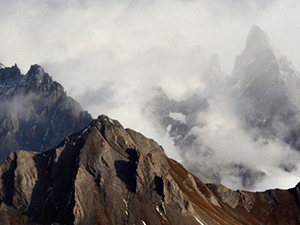NATURAL HAZARDS
RISK. MANAGEMENT PLAN. CROSS-BORDER. MONITORING. PERMAFROST. GEOMORPHOLOGICAL PROCESSES. INDIVIDUAL.
The development of an Alpine-wide risk management plan is at the heart of implementation activities proposed by the ACB. Experiences with natural hazard risk management can only be exchanged effectively and interfaces can only work on the basis of a harmonized data framework and on common tools for early-warning systems.
This Alpine-wide risk management plan on cross-border risks shall include the definition of harmonized methods for risk mapping and monitoring, harmonisation of approaches to deal with residual risks and a common toolbox on measures. The other pathways deal with further actions on Alpine-wide permafrost & erosion monitoring as well as the improvement of precautionary measures at private level.
Alpine-wide risk management plan, focusing on cross-border risks
This pathway develops a starting point for an Alpine-wide risk management plan: a synthesis of existing approaches on natural hazard management related to cross-border risks and a mapping of hazard “hot spots” for critical infrastructures and settlements which are specifically risk-prone. On this basis, a common framework for risk-management of cross-border risks will be developed.
Alpine wide monitoring of permafrost and geomorphological processes
From the perspective of natural hazards prevention, it is important to know whether permafrost areas (e.g. rock glaciers) are still stable and what kind of hazards they could generate. As permafrost areas extend beyond national borders, this pathway foresees a coordinated approach on monitoring permafrost areas and potential erosion effects, including pilot activities.
Support measures to enhance individual risk precaution
This pathways has the objective to strengthen the role of the civil society within the risk governance framework to supplement the risk management approach coordinated by public authorities. A comprehensive toolbox shall support capacity building on individual risk precaution measures and a network of adaptation coordinators is foreseen to support implementation of measures.
NATURAL HAZARDS
RISK. MANAGEMENT PLAN. CROSS-BORDER. MONITORING. PERMAFROST. GEOMORPHOLOGICAL PROCESSES. INDIVIDUAL.
The development of an Alpine-wide risk management plan is at the heart of implementation activities proposed by the ACB. Experiences with natural hazard risk management can only be exchanged effectively and interfaces can only work on the basis of a harmonized data framework and on common tools for early-warning systems.
This Alpine-wide risk management plan on cross-border risks shall include the definition of harmonized methods for risk mapping and monitoring, harmonisation of approaches to deal with residual risks and a common toolbox on measures. The other pathways deal with further actions on Alpine-wide permafrost & erosion monitoring as well as the improvement of precautionary measures at private level.
Alpine-wide risk management plan, focusing on cross-border risks
This pathway develops a starting point for an Alpine-wide risk management plan: a synthesis of existing approaches on natural hazard management related to cross-border risks and a mapping of hazard “hot spots” for critical infrastructures and settlements which are specifically risk-prone. On this basis, a common framework for risk-management of cross-border risks will be developed.
Alpine wide monitoring of permafrost and geomorphological processes
From the perspective of natural hazards prevention, it is important to know whether permafrost areas (e.g. rock glaciers) are still stable and what kind of hazards they could generate. As permafrost areas extend beyond national borders, this pathway foresees a coordinated approach on monitoring permafrost areas and potential erosion effects, including pilot activities.
Support measures to enhance individual risk precaution
This pathways has the objective to strengthen the role of the civil society within the risk governance framework to supplement the risk management approach coordinated by public authorities. A comprehensive toolbox shall support capacity building on individual risk precaution measures and a network of adaptation coordinators is foreseen to support implementation of measures.


